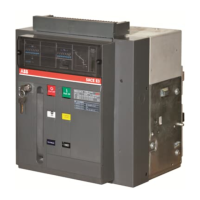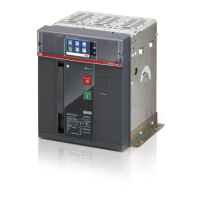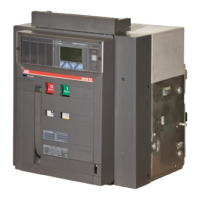N° Doc.
Doc. No.
Mod.
Rev.
M4379
SACE Emax
601933/003
Aparato
Apparatus
Escala
Scale
N° Pag.
Sh. No.
2/100
12.3.2.2 Selección del tipo de curva de actuación (t2) « 55
12.3.2.2.1 Curvas de actuación a tiempo corto inverso « 55
12.3.2.2.2 Curvas de actuación a tiempo independiente « 56
12.3.2.3 Ejemplo de programación « 56
12.3.3 Protección contra cortocircuito instantáneo (I) « 57
12.3.3.1 Selección del valor de umbral (I3) « 57
12.3.3.2 Características del tiempo de actuación (t3) « 58
12.3.3.3 Ejemplo de programación « 58
12.3.4 Protección contra defecto a tierra (G) « 58
12.3.4.1 Selección del valor de umbral (I4) « 58
12.3.4.2 Selección de la curva de actuación (t4) « 59
12.3.4.3 Ejemplo de programación « 59
12.3.5 Protección de umbral fijo contra cortocircuito « 60
12.3.5.1 Selección del valor de umbral (Iinst) « 60
12.3.5.2 Características del tiempo de actuación (tinst) « 61
12.4 Función de prueba de disparo « 61
12.5 Accesorios de la prueba de disparo TT1 « 61
12.6 Función del conector de prueba « 62
12.7 Marco del relé « 62
12.8 Curvas de actuación « 63
12.8.1 Curvas de actuación de la protección “L” « 63
12.8.2 Curvas de actuación de la protección “I” « 63
12.8.3 Curvas de actuación de la protección “S” « 64
12.8.4 Curvas de actuación de la protección “G” « 65
13. Unidad de protección SACE PR112/P-LSI-LSIG
y unidad de protección SACE PR112/PD - LSI
- LSIG « 66
13.1Generalidades « 66
13.2 Sensores amperimétricos « 66
13.2.1 Sensores amperimétricos de fase « 66
13.2.2 Transformador toroidal exterior
“Source Ground Return” « 67
13.3 Interfaz usuario « 67
13.3.1 Display y teclas función « 67
13.3.2 Señalizaciones ópticas « 69
13.3.3 Señalizaciones eléctricas « 69
13.3.4 Puesta a cero de las señalizaciones
ópticas y eléctricas « 69
13.3.5 Función de prueba « 70
13.3.6 Función Read / Edit « 71
13.3.7 Autodiagnóstico del microprocesador « 72
13.4Programación de los parámetros de funcionamiento « 72
13.4.1 Parámetros de configuración básica « 72
13.4.2 Parámetros de comunicación (sólo PR112/PD)
con protocolo INSUM « 77
13.4.3 Parámetros de protección « 78
13.4.4 Parámetros de medida « 82
13.4.5 Parámetros de control y información desde
la unidad SACE PR112/P « 82
13.4.6 Parámetros de control y información desde
la unidad SACE PR112/PD « 83
13.5 Mensajes de configuración equivocada y de alarma « 84
13.5.1 Configuraciones equivocadas « 84
13.5.2 Alarmas para funciones de protección en
temporización o intervenidas « 85
13.5.3 Alarmas generales desde la unidad
SACE PR112/P « 87
13.5.4 Alarmas generales desde la unidad
SACE PR112/D « 88
13.6 Funciones de protección « 88
13.6.1 Protección contra sobrecarga a
tiempo dependiente (L) « 89
13.6.1.1 Selección del valor de umbral (I1) « 89
13.6.1.2 Selección de la curva de actuación (t1) « 89
13.6.1.3 Memoria térmica “L” « 89
13.6.2 Protección contra cortocircuito a
tiempo corto (S) « 90
13.6.2.1 Selección del valor de umbral (I2) « 90
13.6.2.2 Selección del tipo de curva de actuación (t2) « 90
13.6.2.2.1 Curvas de actuación a tiempo corto inverso « 90
13.6.2.2.2 Curvas de actuación a tiempo corto
independiente « 90
13.6.2.3 Memoria térmica “S” « 90
13.6.2.4 Selectividad de zona “S” « 91
13.6.3 Protección contra cortocircuito instantáneo (I) « 91
13.6.3.1 Selección del valor de umbral (I3) « 91
12.3.2.2 Selection of the type of trip curve (t2) « 55
12.3.2.2.1 Trip curves with inverse short time-delay « 55
12.3.2.2.2 Trip curves with definite time-delay « 56
12.3.2.3 Example of setting « 56
12.3.3 Protection against instantaneous short-circuit (I)« 57
12.3.3.1 Selection of the threshold value (I3) « 57
12.3.3.2 Characteristics of the trip time (t3) « 58
12.3.3.3 Example of setting « 58
12.3.4 Protection against earth fault (G) « 58
12.3.4.1 Selection of the threshold value (I4)
«
58
12.3.4.2 Selection of the trip curve (t4) « 59
12.3.4.3 Example of setting
«
59
12.3.5 Fixed threshold protection against
short -circuit
«
60
12.3.5.1 Selection of the threshold value (Iinst) « 60
12.3.5.2 Trip time characteristics (tinst)
«
61
12.4 Trip test function
«
61
12.5 TT1 trip test release accessory
«
61
12.6 Test connector function
«
62
12.7 Release flange « 62
12.8 Trip curves « 63
12.8.1 Trip curves of protection “L” « 63
12.8.2 Trip curves of protection “I” « 63
12.8.3 Trip curves of protection “S” « 64
12.8.4 Trip curves of protection “G” « 65
13. SACE PR112/P-LSI-LSIG protection unit and
SACE PR112/PD-LSI-LSIG protection unit « 66
13.1 General « 66
13.2 Current sensors « 66
13.2.1 Phase current sensors « 66
13.2.2 “Source Ground Return” external toroidal
transformer « 67
13.3 User interface « 67
13.3.1 Display and function keys
«
67
13.3.2 Visual indications « 69
13.3.3 Electrical signals « 69
13.3.4 Resetting of optical and electrical signals « 69
13.3.5 Test functions
«
70
13.3.6 Read / Edit function « 71
13.3.7 Microprocessor self-diagnosis « 72
13.4 Setting the operating parameters « 72
13.4.1 Basic configuration parameters « 72
13.4.2 Communication parameters (only PR112/PD unit)
with INSUM protocol « 77
13.4.3 Protection parameters « 78
13.4.4 Measurement parameters « 82
13.4.5 Control parameters and information
from the PR112/P unit « 82
13.4.6 Control parameters and information from the
SACE PR112/D unit « 83
13.5 Messages for incorrect configuration and alarm « 84
13.5.1 Incorrect configurations « 84
13.5.2 Alarms for protection functions under timing
or tripped « 85
13.5.3 General alarms from SACE PR112/P unit « 87
13.5.4 General alarms from SACE PR112/D unit « 88
13.6 Protection functions « 88
13.6.1 Protection against overload with definite time (L) « 89
13.6.1.1 Selection of the threshold value (I1) « 89
13.6.1.2 Selection of the trip curve (t1) « 89
13.6.1.3 Thermal memory “L” « 89
13.6.2 Protection against short-circuit with short
time-delay (S) « 90
13.6.2.1 Selection of the threshold value (I2) « 90
13.6.2.2 Selection of the type of trip curve (t2) « 90
13.6.2.2.1 Trip curves with inverse short time-delay « 90
13.6.2.2.2 Trip curves with definite time-delay « 90
13.6.2.3 Thermal memory “S” « 90
13.6.2.4 Zone selectivity “S” « 91
13.6.3 Protection against instantaneous short-circuit (I)« 91
13.6.3.1 Selection of the threshold value (I3) « 91
13.6.3.2 Trip time characteristics (t3) « 91
13.6.4 Protection against earth fault (G) « 91
13.6.4.1 Selection of the threshold value (I4) « 92
13.6.4.2 Selection of the type of trip curve (t4) « 92
13.6.4.2.1 Trip curves with inverse short time-delay « 92
13.6.4.2.2 Trip curves with definite time-delay « 92
13.6.4.3 Source Ground Return protection function « 93

